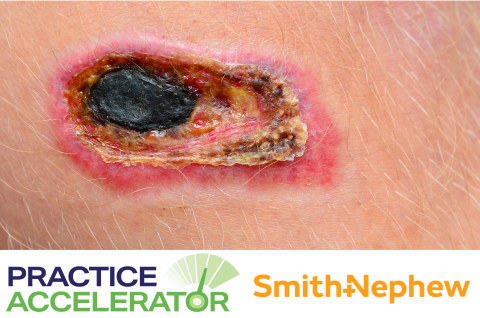Addressing Patient Questions and Misconceptions About Debridement
February 23, 2024
Clinicians often answer patients’ questions regarding their care plan. Sometimes these questions arise from misconceptions or misunderstanding of the process. This piece takes a closer look at a few of these potential questions, and how wound care professionals can dispel the related myths.
“You just debrided the wound last visit. Why do you have to do it again?”
In order to address this concern, it is important for patients to understand the “why” behind debridement. As clinicians know, debridement primarily aims to remove1:
- Devitalized tissue
- Biofilm
- Bioburden
- Unhealthy cells
Biofilm can reform quickly, and exposed tissue may not always remain viable, so serial debridements often become necessary. Debridement is an important intervention that prepares the wound for re-epithelialization. Unhealthy tissue in the wound bed poses a physical barrier to the healing process and to the penetration of topical agents.1 Allowing devitalized tissue, even when invisible to the naked eye like biofilm, to remain within the wound can also prevent accurate wound assessment, including evaluation for underlying infection.1
Determination of debridement frequency depends on a multitude of factors, such as:
- Wound characteristics
- Debridement method
- Interval assessment
- Patient-related factors
- Vascular status
- Dressing type
However, it is not unusual, and in fact it is wise, for debridement to take place at each wound care visit, when indicated.1 A 2021 study polled 53 Australian clinicians who treated diabetic foot ulcers. The study reported that sharp debridement most commonly took place weekly or every other week.2 Determining factors included (in order of prevalence) presence of callus, presence of slough, presence of infection, clinical staff time, patients keeping their appointments, transportation issues, and various cost-related issues for the patient.2
Overall, careful consideration of how to optimally manage debridement for each patient, and thoughtful communication with the patient about the rationale can lead to a better partnership during care.
“Isn’t the wound going to just get worse or become infected if you keep scraping it?”
Quite the opposite is true when it comes to this misconception. Clinicians are very aware of chronic wounds and their infection risk. However, some patients without this understanding may erroneously feel as though various methods of debridement may actually hinder, rather than help, their healing process. This is another scenario in which effective patient education is vital.
How Much Do You Know About Debridement? Take our quiz to find out! Click here.
Share with patients that unhealthy, especially necrotic, tissue provides a nutrient source for microorganisms like bacteria.1 By removing or breaking up this unhealthy tissue through debridement, the clinician addresses a potential cause of sepsis, localized infection, and antibiotic resistance. Depending on the method, debridement also allows for the collection of more accurate tissue cultures.3 The entire foundation of wound debridement is meant to encourage re-epithelialization and healing by stimulating and properly preparing the wound bed to support the rest of the wound care plan.1,3 Communicating this understanding to the patient can illuminate why this procedure is so important for wound healing.
“Debridement sounds like it’s painful. Do I need anesthesia?”
Control of discomfort or pain related to debridement is a vital consideration for clinicians, and patients may express fear based on past experiences, or a lack of understanding about the procedure. The vast majority of debridement methods do not necessitate an operating room environment, nor do they require general anesthesia. While aggressive operative sharp debridement is an important pathway in some cases, clinicians can reassure patients that multiple options exist for debridement outside of the operating room.1 There are also a variety of choices available to address periprocedural pain.
Educating patients about pain control with debridement begins with a better understanding of wound-related pain. The noxious stimulus from debridement, possible neuropathic dysfunction, or background pain can play a role.4 A thorough assessment prior to debridement may allow the clinician to more deeply understand the risks or challenges unique to each patient. One can then determine the best debridement circumstances, addressing the wound’s needs while remaining cognizant of pain control. In some cases, clinicians may choose a form of debridement less likely to cause pain. Additionally, they may employ options like topical, local, or regional anesthesia.5,6
Thoughtful consideration of each patient’s pain risks, and compassionate choices related to the employed debridement method could go a long way in establishing trust and successful debridement outcomes. Sharing the rationale behind these choices, and reassuring the patient that pain mitigation is available may dispel concerns.
Final Thoughts
These commonly expressed patient concerns further reinforce the benefit of comprehensive and tailored wound assessment to choose the best debridement method to support wound healing. In doing so, one can educate patients on these choices, engage them in the process, and dispel misconceptions that may arise.
References
- Manna B, Nahirniak P, Morrison CA. Wound Debridement. In: StatPearls [Internet]. Treasure Island (FL):StatPearls Publishing;2024. https://www.ncbi.nlm.nih.gov/books/NBK507882/
- Nube VL, Alison JA, Twigg SM. Frequency of sharp wound debridement in the management of diabetes-related foot ulcers: exploring current practice. J Foot Ankle Res. 2021;14:52.
- Turner CT, Pawluk M, Bolsoni J, et al. Sulfaphenazole reduces thermal and pressure injury severity through rapid restoration of tissue perfusion. Sci Rep. 2022 Jul 23;12(1):12622.
- Thabet T. Wound pain: do you know the physiology? WoundSource. Published March 3, 2023. https://www.woundsource.com/blog/wound-pain-do-you-know-physiology.
- Claes KEY, Amar S, Hoeksema H, Kornhaber R, de Jong A, Monstrey S, Haik J, Biros E, Harats M. Pain management during a bromelain-based selective enzymatic debridement in paediatric and adult burn patients. Burns. 2022 May;48(3):555-567.
The views and opinions expressed in this blog are solely those of the author, and do not represent the views of WoundSource, HMP Global, its affiliates, or subsidiary companies.












Follow WoundSource
Tweets by WoundSource